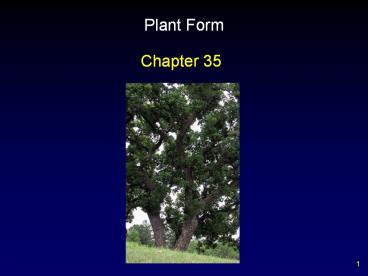Plant Form - PowerPoint PPT Presentation
1 / 33
Title:
Plant Form
Description:
Primary growth results from cell division at the apical meristem at the plant tip. ... Apical meristem daughter cells divide into protoderm, procambium, and ... – PowerPoint PPT presentation
Number of Views:60
Avg rating:3.0/5.0
Title: Plant Form
1
Plant Form
- Chapter 35
2
Meristems
- Meristematic tissues are clumps of small cells
with dense cytoplasm and proportionately large
nuclei. - Elongation of roots and shoots takes place by
repeated cell divisions and subsequent elongation
by the apical meristem. - In some species, lateral meristems produce an
increase in girth.
3
Meristems
- Apical meristems
- located at tip of stems and roots
- Plant tissues that result from primary growth are
called primary tissues. - make up primary plant body
- root apical meristem protected by root cap
4
Apical Meristems
- Give rise to three types of primary meristems
- protoderm - forms epidermis
- procambium - forms primary vascular tissue
- ground meristem - differentiates into ground
tissue - intercalary meristems may arise in stem internodes
5
(No Transcript)
6
Lateral Meristems
- Most trees, shrubs, and some herbs have active
lateral meristems. - increases girth in nonwoody plants - secondary
growth - Woody stems
- cork cambium
- produces cork cells
- vascular cambium
- produces secondary vascular tissue
7
(No Transcript)
8
Organization of the Plant Body
- Vascular plant consists of
- root system - anchors plant and penetrates soil
to absorb water and ions - shoot system
- stems framework for positioning leaves
- leaves - principle sites of photosynthesis
- vegetative shoot - internode, node leaf and
axillary buds
9
Plant Body Diagram
10
Organization of the Plant Body
- Tissue types
- ground tissue - parenchyma cells
- dermal tissue - outer covering
- epidermis in primary growth plants
- cuticle
- bark in secondary growth plants
- vascular tissue - conduction
- xylem - water and dissolved materials
- phloem - carbohydrates
11
Primary and Secondary Growth
- Primary growth results from cell division at the
apical meristem at the plant tip. - Secondary growth results from cell division at
the lateral meristem, increasing the shoots
girth.
12
Dermal Tissue
- Epidermal cells originating from the protoderm
cover all parts of the primary plant body. - guard cells - dumbbell-shaped cells flanking
stomata - trichomes - hairlike outgrowths
- regulate microclimate
- root hairs - tubular extensions of epidermal
cells - increase roots surface area
13
Ground Tissue
- Parenchyma
- store food and water
- Collenchyma
- provide support for plant organs
- Sclerenchyma
- supporting function
- secondary walls impregnated with lignin
- fibers and sclerids
- may be nonliving at maturity
14
Ground Tissue
15
Vascular Tissue
- Xylem
- principle water-conducting tissue
- combination of vessels and tracheids
- primary xylem derived from procambium
- secondary xylem formed by vascular cambium
- wood made of accumulated secondary xylem
16
Vascular Tissue
- Phloem
- principle food-conducting tissue in vascular
plants, located toward the outer part of roots
and stems - carried out through sieve cells and sieve-tube
members - some sieve areas (pores) have larger pores called
sieve plates - each sieve-tube member associated with companion
cell
17
Sieve-Tube Member
18
Root Cells Differentiate
- Root structure
- root cap
- composed of inner columella cells and lateral
root cap cells - new root cap produced when existing cap is
removed - functions in gravity perception
19
Root Structure
- Zone of cell division
- cells divide every 12 to 36 hours toward the
edges of the concave dome - Apical meristem daughter cells divide into
protoderm, procambium, and ground meristem
tissues. - Zone of elongation
- roots lengthen because cells produced by primary
meristems grow longer than wide
20
Root Structure
- Zone of maturation
- cells differentiate into specific cell types
- root surface cells mature into epidermal hairs,
each with root hair - cortex produced by parenchyma cells
- inner boundary differentiates into endodermis
- surrounded by Casparian strips composed of suberin
21
Root Structure
22
Modified Roots
- Most plants produce either a taproot system
(single large root with smaller branch roots) or
a fibrous root system (many smaller roots of
smaller diameter).
23
Woody Twig
24
External Stem Form
- Leaf
- blade - flattened portion
- petiole - stalk
- sessile - no petiole
- axil - space between petiole and stem
- axillary bud
- terminal bud
- stipules - appendages at base of leaf
- stipule scars
25
Stems
26
Modified Stems
- Special purpose modifications
- bulbs
- corms
- rhizomes
- runners and stolons
- tubers
- tendrils
- cladophylls
27
(No Transcript)
28
Leaves
- Leaf external structure
- microphylls - have one vein that does not leave a
gap when it branches from the vascular cylinder
of the stem - megaphylls - have several veins that leave a gap
when they branch from the vascular cylinder of
the stem
29
Leaf External Structure
- Simple leaves - undivided blades
- Compound leaf - blade divided into leaflets
- pinnately compound - leaflets arranged in pairs
along common axis - palmately compound - leaflets radiate out from
common point
30
Leaf External Structure
- Leaf arrangement
- alternate - one leaf per node
- opposite - two leaves per node
- whorl - circle of leaves at same level
31
Leaf Internal Structure
- Epidermis has waxy cuticle and may have tricomes
- lower epidermis contains stomata flanked by guard
cells - Mesophyll - tissue between upper and lower
epidermis - Dicots have rows of cholenchyma cells
constituting the palisade mesophyll. - spongy mesophyll between palisade mesophyll and
lower epidermis - monocot mesophyll not differentiated
32
Leaf Cross Section
33
Modified Leaves
- Modifications
- floral leaves (bracts)
- spines
- reproductive leaves
- window leaves
- shade leaves
- insectivorous leaves































